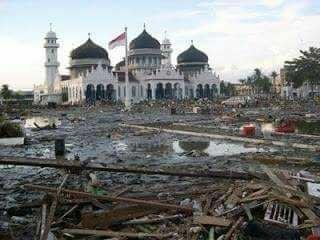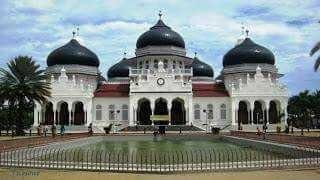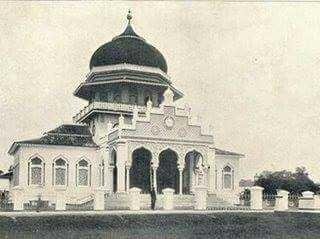Big mosque Baiturrahman Witness History of Aceh
Baiturrahman Great Mosque

Aceh History Witness
Baiturrahman Mosque has become the symbol of Aceh. Tracing the history of the mosque in the heart of Banda Aceh, is like looking at the earth trip Serambi Mecca. starting from the time of the sultanate, the Dutch colonialism and the joint period of Indonesia complete with his rebellion. Start Military Operation Area, peace agreement until tsunami disaster. This house of worship watches it all
History records, Baiturrahman returns through a round in the history of the people of Aceh. This mosque is a symbol of Aceh. The journey of this mosque also records the history of Aceh. Because it was incomplete when visiting Aceh, without visiting this five domed mosque and a little familiar with its history.

This mosque has been in the middle of the city of Banda Aceh since the time of the empire. There are two versions of the saga establishment. Some call the Sultan Alauddin Johan Mahmud Shah build this mosque in the 13th century. In another version states Baiturahman was founded in the 17th century, during the heyday of the reign of Sultan Iskandar Muda. No one can be sure which one is true. The name Baiturahman, according to historical records, was given by Sultan Iskandar Muda. At that time this mosque became one of the central development of Islamic teachings of the kingdom of Aceh. The physical changes of the mosque follow the history of the earth of Serambi Mecca. The visible building is no longer a building during the time of the empire. At the time of the sultanate, Baiturahman architectural style similar to old mosques in Java. A wooden building with a square and multilevel roof that has 1 dome. In 1873, the mosque was burned by the Dutch because the mosque was used as the center of the strength of the Aceh army against the Dutch. And in that year there was also a great battle between the people of Aceh and the Dutch army. The shoot that killed one of the Dutch officers named Kohler. The battle at the Mosque is remembered through the construction of the Kohler inscription on the Mosque grounds. The location of the inscription under the Geulempang tree, which grows near one of the gates of the Mosque.
The laying of the first stone of the rebuilding of the Mosque was done in 1879 by Tengku Malikul Adil, witnessed by the Governor of the Dutch East Indies Military in Aceh at the time, G. J. van der Heijden. The construction of the mosque was designed by the Italian architect of Italian descent, De Brun. The building materials of the Mosque are partly imported from Penang - Malaysia, marble stones from the Netherlands, marble for stairs and floors from China, iron for windows from Belgium, Burmese wood and mosque poles from Surabaya. Rebuilding the Mosque with one dome, finished two years later. At the time of the resident Y. Jongejans reigned in Aceh The mosque was re-expanded. Then after that, the people of Aceh getting bigger, to mengerahi and defuse the anger of the people of Aceh then the mosque expanded again left right in three years later. Two more domes were added on top of it to become three domes. The Dutch then left Aceh. earth naggroe turns to Indonesia.

In 1957, the reign of President Soekarno, the Mosque changed again. Two new domes are made at the back. Also built two towers with the number of poles reaching 280 units. Due to this expansion, a number of shops in the Aceh market located around the mosque were displaced. Laying the first stone was done by the minister of religion of the Republic of Indonesia at that time KH Ilyas, then built approximately four years. The next building had reached the following tower. The renovation of the mosque by the Soekarno government took place during the Darul Islam movement led by Daud Beureueh. So many people who linked the development as a government effort to reduce the rebellion. Five domes are also considered to represent the Pancasila initiated by Sukarno. In the period 1992-1995, the Mosque was restored and expanded to seven dome and five towers. Once restored, the mosque was able to accommodate 10,000 to 13,000 worshipers. The Mosque courtyard was also expanded.
